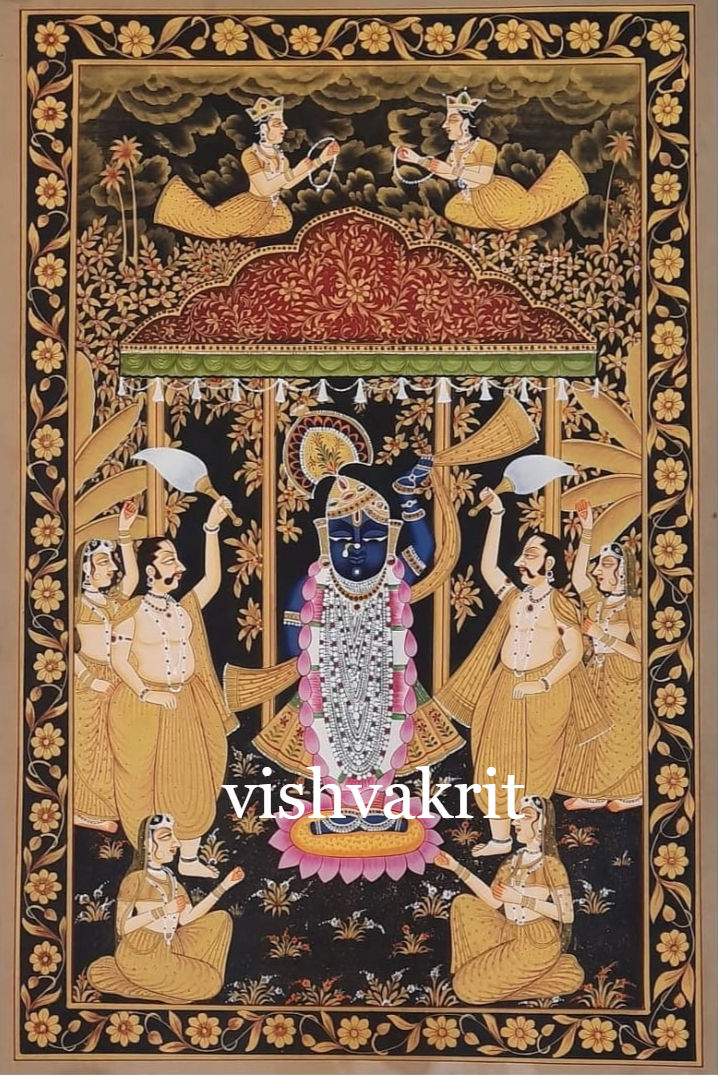Unveiling the Magic of Vishvakrit Paintings: Vastu Remedies Through Exquisite Pichwai Art from Rajasthan
- Renu Dutt Sharma
- Jun 1
- 4 min read
Vishvakrit paintings represent a captivating facet of traditional Indian art. Originating from the culturally rich state of Rajasthan, these exquisite pichwai artworks are celebrated for their intricate designs and deep spiritual significance. Characteristically vibrant, they often illustrate scenes from Lord Krishna's life, sparking joy and peace within homes. These paintings not only enhance aesthetic appeal but also serve as vastu remedies, contributing to a harmonious energy within your living environment.

In this exploration, we will uncover the enchanting world of Vishvakrit paintings, highlighting their unique features, artistry, and transformative impact on home decor.
The Essence of Pichwai Art
Pichwai art, traditionally painted on cloth, reflects Rajasthan's cultural heritage through intricate designs and motifs. The name "pichwai," meaning "hanging at the back," signifies its original purpose of decorating Krishna temples.
Contemporary Vishvakrit paintings are crafted by skilled artisans with great attention to detail. For instance, every single stroke narrates a story, often portraying cherished characters from Hindu mythology. These vibrant colors and detailed patterns not only create visual appeal but also evoke tranquility, making them ideal for homes in search of balance and grace.
Statistically, around 70% of people who incorporate traditional art into their homes report feeling an increase in positive energy. This statistic highlights the impact of art, like the Vishvakrit paintings, on emotional well-being.
Vastu and Art: A Harmonious Blend
Vastu Shastra, the ancient Indian architecture science, stresses the importance of layout and design in enhancing energy flow within spaces. Vishvakrit paintings play a vital role in this philosophy, acting as effective vastu remedies that influence the room's ambiance.
The colors and symbols used in these paintings are purposefully chosen. For instance:
Green and blue signifying peace and serenity
Yellow and gold promoting prosperity and wealth
By integrating Vishvakrit paintings into your home, you create an atmosphere that fosters well-being and harmony, leading to increased happiness and productivity.
The Artistic Process: Handmade with Love
A defining aspect of Vishvakrit paintings is their handmade nature, showcasing the exceptional talent and commitment of Rajasthan's artisans. The journey of each painting begins with a meticulous sketch, followed by the application of vibrant natural colors sourced from minerals and plants.
Artisans then carefully layer these colors and add intricate details, ensuring that no two pieces are the same. This labor-intensive approach not only adds uniqueness to each artwork but also highlights the cultural richness and craftsmanship of Rajasthan. Each painting is a support for these artisans, preserving their heritage.
For example, it can take up to two weeks for a single artwork to be completed, with artisans often working over 12 hours a day to perfect their craft.
Choosing the Right Painting for Your Space
Selecting the right Vishvakrit painting involves considering the energy of the space and desired ambiance. For instance, a peaceful scene of Krishna in a lush garden is excellent for a bedroom, encouraging tranquility and restful sleep.
On the other hand, a lively depiction of Krishna's playful childhood can uplift the mood in a living room, filling the area with joy and positivity. Understanding the emotional and spiritual significance of these paintings can guide you in choosing the perfect piece that resonates with your family’s values and aspirations.
Care and Maintenance of Vishvakrit Paintings
To maintain the beauty of your Vishvakrit paintings, follow these simple care guidelines:
Avoid direct sunlight: Display your painting away from direct sunlight to prevent color fading.
Dust gently: Use a soft, dry cloth to dust the artwork regularly. Moisture should be avoided to protect the piece.
Frame wisely: Opt for protective framing with glass to preserve and showcase the painting's beauty.
By adhering to these tips, you ensure that the vibrancy and significance of your Vishvakrit artwork last for years.
Benefits Beyond Aesthetics
Beyond their beauty, Vishvakrit paintings offer a multitude of benefits that extend beyond mere decoration. The spiritual significance infused in each piece allows homeowners to connect deeply with their culture and history.
Incorporating these paintings into your home acts as a daily reminder of peace, spirituality, and the natural beauty around us. As artworks that also serve as vastu remedies, they help create an environment conducive to happiness and productivity.
Research indicates that homes adorned with meaningful art see a 30% increase in overall family satisfaction, emphasizing the positive impact of such artworks.
The Legacy of Vishvakrit Paintings
Vishvakrit paintings thrive today, thanks to artisans' dedication and a growing appreciation for traditional crafts. By choosing to incorporate these extraordinary pieces into your home, you enhance your living space while honoring the cultural legacy of Rajasthan.
The artistry and importance of Vishvakrit paintings make them essential for anyone looking to enrich their home with both meaning and beauty.
Embracing the Beauty of Vishvakrit Art
Vishvakrit paintings are more than just artistic pieces; they serve as a connection to history and culture, merging beauty with spiritual meaning. As handcrafted works from Rajasthan, they embody the passion and skill of their creators, allowing you to bring a piece of cultural heritage into your home.
By recognizing the role of these artworks as vastu remedies, you can enhance the positive energies in your living areas. Whether you choose a serene depiction or a vibrant celebration of Krishna's life, every Vishvakrit painting serves as a reminder of the beauty and balance that art can achieve.
Let these stunning creations infuse your home with harmony, joy, and cultural significance.




Comments